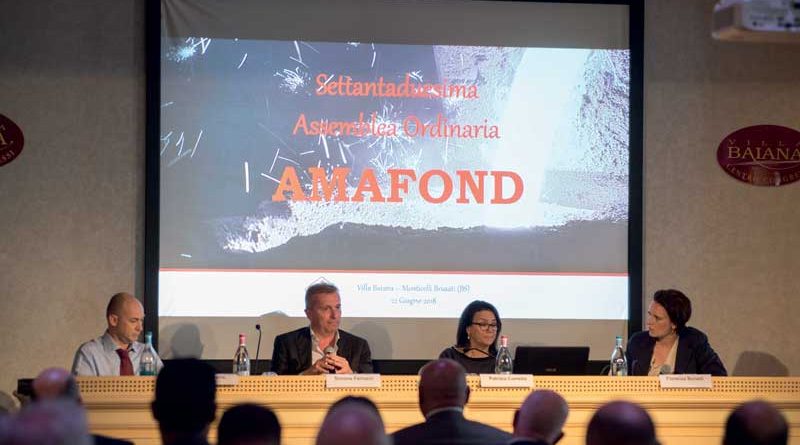Seventy-Second Meeting for Amafond
Villa Baiana, an extraordinary estate among Franciacorta’s vineyards, was the beautiful setting for the seventy-second assembly of Amafond, the association which as from 1946 represents the suppliers of materials and machinery for the foundry
by Giuseppe Giordano
The companies associated to Amafond are a few dozen more than one hundred and range from manufacturers of robots specifically designed for foundry operations to companies which produce presses for die casting, to suppliers of chemicals to improve the quality of the liquid metal and the ensuing solid. These companies are the heirs of great technical assets, but also of a long associative tradition which has been lasting since 1946. In compliance with this tradition, the large 300-seat convention room in Villa Baiana was almost full and the event was attended by a particularly inclusive audience. On the other hand, the report presented by the assembly contained very interesting data, deriving from a detailed analysis of the market. From the assembly’s report what emerges is first and foremost a message of optimism: foundry activities are going through a positive phase worldwide. The automotive market is the main force driving product volumes upwards. Currently the global production of ferrous and non-ferrous castings adds up to about 100 million tons. Over 46 million of these are produced in China, which has a production volume about 4 times that of India, the first runner-up. Following in the ranking list are the United States, Germany, Japan, Russia, Korea and Mexico. Italy produces about 2 million tons of castings, subdivided as shown in figure 1. Aluminium used for product classes typical of foundries added up to roughly 850,000 tons in 2017. Amafond companies generate revenues of about 1.5 billion euro and employ about 6,000 operators. Like many other industries, even the Amafond sector presents a significant share of export revenues (332 million euro in 2017) generated on markets with a high rate of vehicle production. Amafond companies in their activity abroad are able to keep up a consistent global role and even to detect scenario variations, as shown by figure 3 illustrating the comparison of export revenues to various countries from 2016 to 2107. After the Assembly which elected the new managing board, Amafond organized a round table open to the public. The event was attended by two young entrepreneurs who recently took the helm of a company whose activity is based on a foundry, and a manager in charge of a large foundry operating in a leading global automotive supplier group such as Brembo. The round table was moderated by Fiorenza Bonetti, a journalist with a good knowledge of the Amafond market and of its peculiarities. The two young entrepreneurs were Patrizia Comello, Managing Director and shareholder, Fonderia di Montorso, and Simone Ferrucci, CEO and co-owner, Tecnomeccanica. The foundry in Montorso Vicentino every year produces cast iron items adding up to about 45,000 tons destined among others to the hydraulic sector, to various types of pumps and to the automotive industry.
Mr. Ferrucci for the past 18 months has been at the helm of Tecnomeccanica, an excellent company in the automotive headlamp component segment, which operates in Novara starting off from a low pressure die casting technology foundry for the production of headlamp reflectors. The company is going through its own changes and at the same time the revolution of LEDs in the automotive industry, which change everything from the type of support for the lighting element to the working life span. It is therefore now essential not to get the investments in machines wrong and especially to have the right skills available.
The third participant to the round table was Mr. Luca Ozella, manager of Brembo’s Mapello foundry, particularly active in the production of brake discs and calipers. The managerial experience accrued within a world leading group also has peculiarities due to the comparison with group structures which produce the same products in environmental conditions which are quite different.
Stimulated by the moderator’s questions, the three speakers were able to present their experience as entrepreneurs and managers, often sharing growth issues and productivity improvement efforts. All of them brought forward their stories, with many points in common, especially in the drive provided to innovation and change, in spite of the belief that the current markets should not be abandoned; indeed, the capability of being among the leaders in these markets should be increased.

